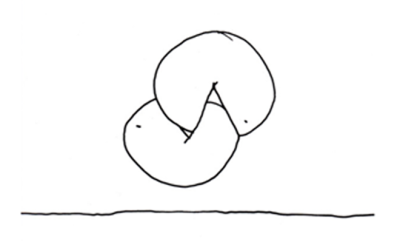
The Magic State of Acceptance
“One of the most powerful influences on emotional health and well-being is the capacity to accept reality, to accept what is. The extent to which one can accept what is profoundly affects his psychological ability to adapt.” Joseph Dunn, Ph.D. Psychologist
One doesn’t have to read far in the field of psychology to begin to realize the awesome power of acceptance . I learned this surprising secret very early when I came across a shocking quotation from Alfred Alder and then another from Carl Jung. Both said that you can never get over a neurosis until “you can love your neurosis.” My first thought was, “Love one’s neurosis?” you’ve got to be kidding! That’s the last thing I would want to do.
Yet it is in and through acceptance that we are healed, released, and freed for emotional health and well-being. The use of the term “love” was used to call attention to the absolute necessity of acceptance. In this, acceptance, as a key ingredient for effective coping and for mastering the challenges of life, acceptance surprisingly and paradoxically offers us one of the most powerful transformative tools. There’s hardly anything more profound in human nature than acceptance.
Now if this seems preposterous, remember that acceptance as a transformative process has long been known. Consider the serenity prayer:
“God grant me the serenity to accept the things I cannot change, the courage to change the things I can, and the wisdom to know the difference.”
The word acceptance (from Latin and French) literally means “to take, receive, or hold.” In accepting, we “receive with consent, give admittance, sometimes give approval to, endure without protest, regard as proper, normal, or inevitable, and receive as true.” The mental side of acceptance is to receive something into the mind for understanding and comprehension. The emotional side of acceptance involves welcoming something into our being.
The Paradox of Acceptance
This is the paradox of acceptance. What we accept, we defuse and release. What we do not accept, but fight against and resist, we give energy to so that it grows. It becomes increasingly unmanageable, and controls us. The opposite of just accepting ourselves, life, the world, others, the constraints that we face everyday, the cards life has dealt us, is the first step to true mastery and empowerment. It is the first step, not the last.
The lack of acceptance leaves us unable to face reality. It undermines our ability to cope with the basic facts of what is . When we don’t accept something, we are rejecting, denying, repressing, and fighting. We pump our brains full of thoughts about non-acceptance. We do so with unrealistic expectations, impossible desires, and erroneous understandings that set us up for refusing to face things.
Acceptance is not resignation. Resignation refers to giving up or giving in. In resignation a person lies down and takes it. That’s not acceptance. Acceptance welcomes into mind and life with the purpose of effectively responding to it. In this, acceptance is not complacency or passivity, and it does not indicate the lack of high standards. Again, Dr. Joseph Dunn on this subject:
“Acceptance is usually the initial step and a critical one, in any psychological condition or symptom. Dealing effectively with depression, anxiety, conflict, or destructive habits begins with acceptance. Often the most difficult part of therapy is struggling with resistance to face reality.”
The lack of acceptance drives perfectionism. Conversely, acceptance of what is conquers perfectionism and other forms of mental and emotional intolerance. In the real world we find all kinds of ambiguities. We don’t have neat categories of black-or-white compartments.
Acceptance is critical for relationships because without it, we go about trying to change the other. And that interferes with allowing each person to take responsibility for changing. Acceptance enables us to suspend our defenses and judgments that interfere with accurate perceptions. Relationally, the ability to live with differences depends upon acceptance.
Forgiveness is an acceptance grace. It enables us to come to terms with major hurts that we cannot just dismiss. Acceptance enables humor and laugher. Humorist Woody Allen illustrates the power of humor in acceptance, “I wasn’t born a good looking kid, I didn’t acquires these looks until later in life.” As part of the art of acceptance, humor, as a way to gain psychological distance, enables us to laugh things off.
We can accept without endorsing. We can accept a person without approving of everything that person thinks, feels, or says. Acceptance is part of contentment. Learning to accept life circumstances while fixing our eyes on values that have true meaning is essential for living a contented and peaceful life. Releasing what we cannot control makes for acceptance.
The Art of Acceptance
- What do you have a challenge accepting?
- What problems or situations do you find yourself fighting against?
- What do you say “I can’t stand…?”
- How well do you accept yourself with all of your imperfections and fallibilities?
- How well do you accept your world or others?
If acceptance is such a powerful and healing influence as a state and as a frame of mind, how do we learn it? How do we practice it? How can we develop more ready access to it and use it when we need it?
The art of acceptance starts in the mind as a way of thinking about things and perceiving. It begins as we notice what we already “accept” rather than reject. It’s best to begin by thinking of something small and simple that you accept. How about the rain, traffic in a big city, lines at the airport, the baby’s diaper needing to be changed, someone has to take the garbage out? Think about something perhaps that you once did not accept, but rejected, hated, and found intolerable yet over the years, you have come to just accept.
As you think about something small that you accept, see and hear it on the theater of your mind until you step into that experience and feel it. When you do, notice how you are breathing, your muscle tension, your gestures, movements, voice, tone, eyes, face, etc. Take a snapshot of this experience of acceptance. To learn this even better, think of something that you definitely do not accept. Do the same with it, see and hear it until you step in and feel it then take a snapshot of that state. Are these different states?
Identify the language of acceptance and non-acceptance. When we don’t accept we typically utilize the language of the can’ts.
“I can’t stand to fail, that would be terrible.” “I can’t stand to be laughed at.” “I can’t tolerate having to wait.”
Of course, these are psychological can’ts, not actual limitations and constraints as in “I can’t fly.” Psychological can’ts drive our intolerance and non-acceptance and indicate frames of prohibition which taboo the experience under consideration. Now to undo the damage of prohibition, there’s a radical operation needed: we need to step up and give ourselves permission.
“I give myself permission to fail.” “I give myself permission to be human, fallible, to live in a fallible world, to make mistakes, to learn from them, to make the most of things,” etc.
Re-setting your frames occurs as you give yourself permission. Simply continue to do so until it becomes a felt reality for you, until it becomes emotional acceptance. This is the power of changing our internal dialogue. Dr. Joseph Dunn writes:
“Real acceptance involves being open to emotionally absorb or digest what is . There is an absence of emotional defensiveness and avoidance.”
In the end, acceptance is just a state of mind-and-emotion. While there are spiritual traditions that have rituals that take years to achieve in terms of achieving acceptance, it doesn’t have to be that difficult if it is just a state. Nor does the “stages of grief resolution” have to be so long and hard. In Elizabeth Kubler-Ross analysis of the grief stages, a person moves from shock, denial, bargaining, depression, and finally moves on to (guess what?) acceptance. Yet if acceptance is just a mind-body state, why not just start there?
Every mind-body-emotion state is simply that—a state of mind, of body, and emotion. This gives us the “royal roads to state” of what we’re thinking and how we’re using our physiology. That’s why “thinking about a time when …” you had an experience of acceptance with something small and simple, noticing the state of your body in all of its dimensions empowers you with the ability to access acceptance and use it to set accepting frames of mind about other things.
To summarize the process:
- Identify an experience of acceptance.
When have you just accepted something for what it is ?
What do you now accept that once you fought, rejected, and hated?
How does your current acceptance improve the quality of your life? - Fully access the experience.
What do you see, hear, and feel when you recall that accepting experience?
How much do you feel the state of acceptance?
What would make it stronger for you?
What is it like in your body? Breathing, gestures, movements, etc.? - Set an anchor for this state.
Link some special word, gesture, symbol, etc. for this state.
Step in and out of the state until you can trigger the anchor and quickly get back into state. - Apply the acceptance to another area where you need and want acceptance.
What other area of life are you non-accepting, judgmental, intolerant, rejecting, resigning?
Trigger the anchor of your acceptance state and hold as you link that state with whatever you want to be more accepting.
Summary
- There’s hardly another state as healing or freeing as acceptance . It powerfully enables us to adjust ourselves to reality for what it is and to then take the next step in moving forward in a positively creative way.
- Ultimately, acceptance is just a state which means we can use the tools and processes in NLP and Neuro-Semantics to access the state and use it to set new frames of mind about other areas of life where acceptance would free and renew us.







